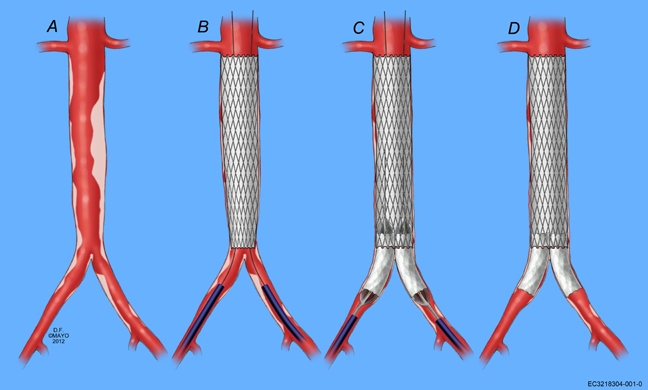|
Back to Annual Meeting Posters
“Endovascular aorto-iliac bypass” using aortic stent graft components and covered stents in patients with TASC D lesions and narrow distal aortic diameter
Mateus P. Correa, MD, Gustavo S. Oderich, MD, Bernardo Mendes, MD.
Mayo Clinic, Rochester, MN, USA.
Objectives: To describe the feasibility and early outcome of a novel technique using aortic stent graft components and covered stents in patients with difficult TASC D aortoiliac lesions and narrow distal aortic diameter.
Methods: We reviewed the clinical data and outcomes of five high-risk patients treated for TASC D aortoiliac lesions using a novel hybrid endovascular technique between 2011 and 2012. All patients had narrow aortic diameter (<14mm) and/or extensive atherosclerotic debris and plaque extending from the infrarenal aorta into one or both iliac arteries. Aortoiliac stenting was performed using 16-18 mm AneuRX stent grafts extensions (Medtronic Vascular, Santa Rosa, CA) for the infrarenal aorta (Figure), ‘kissing’ iCASTs (Atrium Medical Corp., Hudson NH) covered stents for the aortic bifurcation and common iliac arteries and self-expandable stents for the external iliac arteries.
Results: There were 3 male and 2 female patients with mean age was 63+11 years old. Indications were disabling claudication in 4 and rest pain in 1. Mean outer and inner distal aortic diameter were 17+4 and 8+1, respectively. All patients had successful aortoiliac stenting and four required femoral endarterectomy and patch angioplasty. There was no rupture, distal embolization or major complication associated with the procedure. Mean hospital stay was 3.8+2.7 days. Mean ankle-brachial index increased by 0.15 in the right (0.67+0.01) and by 0.28 in the left extremity (0.98+0.23). Mean outer and inner distal aortic diameters were 18+2 and 17+1, respectively. After a median follow-up of 4 months (range, 1 to 10 months) there were no restenosis or re-interventions. All patients continue on clopidrogel and aspirin therapy.
Conclusion: Aortic stent grafts components and covered stents can be used for ‘endovascular aortoiliac bypass’ reconstruction in patients with difficult TASC D lesions and narrow distal aortic diameter. This technique in carefully selected patients was not associated with rupture, distal embolization or early restenosis or occlusion. Long-term follow up is needed. 
Back to Annual Meeting Posters

|

